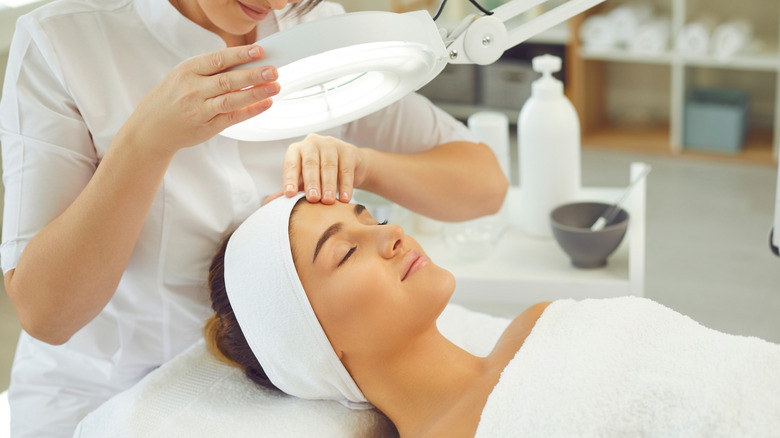What Your Dry Patches Are Trying To Tell You
We may receive a commission on purchases made from links.
When it comes to skin, there's never a one-size-fits-all solution. Skin types can range from oily and acne-prone to sensitive and dry. On top of that, your skin can evolve at any point in your life, producing drastically different levels of sebum (aka natural oils) depending on your age, surrounding environment, and hormone levels. The eyes might be a window to the soul, but the skin is a reflection of your overall health. When it comes to tackling skin conditions like acne, it's sometimes better to take an inside-out approach, reexamining your lifestyle rather than relying solely on TikTok topical solutions like slugging or pore vacuums.
Dry skin, specifically, is more than just uncomfortable — if left untreated, it can lead to long-term consequences. "Cracks allow germs and bacteria to enter the body, which can potentially lead to a skin infection," Melanie Speed, R.N., B.S.N., C.A.N., warns Healthline. When in doubt, here's what your dry patches might be trying to tell you. More often than not, your body is reacting to a dry climate.
Turn down the heat
To combat the cold weather, it's only natural to crank up the furnace, throw some wood on the fire, and bring your space heaters out of storage. However, even though central heating may make your home feel cozy during chilly winter months, it also depletes the air of much-needed moisture. Wintertime is notorious for decreased humidity, and indoor artificial heating only worsens the problem.
Reintroduce moisture into your home with the help of a humidifier. If you have lots of square footage, think about investing in more than one. Most importantly, give your skincare routine a helping hand and keep a humidifier running in your bedroom while you sleep. Barring a particularly cold winter season, opt for blankets and fuzzy socks rather than central heating. Not only will this save you money on gas, but it will also keep those wintertime flaky patches to a minimum. When you do go outside, protect your hands from the dry air with gloves and carry lotion in your pocket.
Reexamine your skincare routine
Build your skincare routine around dry skin. For starters, keep in mind that certain cleansers can be ultra-drying, especially those meant to help with excess oil. Products that contain benzoyl peroxide, salicylic acid, and glycolic acid — usually meant for targeting breakouts — can be especially harsh on dry skin. Additionally, look out for moisturizers, cleansers, or toners that advertise fragrance, as this can also trigger irritation. Take a break from exfoliation if your skin is particularly red or flaky, and prioritize hydrating ingredients like ceramides and hyaluronic acid; use retinol twice a week at most.
If you're experimenting with new skincare ingredients, take your time to research proper application techniques. When it comes to hyaluronic acid, improper use will negate its many benefits. As Beverly Hills-based dermatologist Ava Shamban, M.D., outlines for Refinery29, "Apply your hyaluronic acid on damp skin, and then apply moisturizer on top of it," also noting, "If your skin is already dry, you could actually be doing more harm than good."
Finally, high-coverage foundation or concealer won't stick to dry patches. Instead, rely on tinted moisturizers. Avoid allergic reactions by keeping your sponges and brushes clean, and if you're still experiencing irritation, check to see if your products have expired.
Cut back on those hot showers
Got dry patches? You might be spending too much time in the shower. Prolonged exposure to water, especially hot water, will suck those natural oils straight out of your skin. Though it might not be the most comfortable solution, start by turning down the water temperature. At the very least, a cold blast will jolt you out of the shower. After you're done bathing, take care to rehydrate your body. "Some skin care products, such as moisturizers, work better when applied to damp skin as part of their function is to seal moisture in," board-certified dermatologist Dr. Dina Strachan explains to Healthline. TikTok creator Dr. Daniel Sugai (known under the handle @drspf) recommends CeraVe moisturizing cream, showing his followers how to apply it two to three minutes post-shower and before workouts. Best of all, this product can be used on the face and body.
If your profession requires regular exposure to water — or if you're cursed by a near-constant stack of dishes in the kitchen sink — invest in a pair of rubber gloves to keep your hands protected while you work.
You might be getting too much sun exposure
Never underestimate the importance of sunscreen. Not only does it help prevent skin cancer, but it can also delay the appearance of fine lines and wrinkles. If you have dry skin, keep in mind that prolonged and unfiltered sun exposure will only make it worse. "The water content in the skin is depleted, and the Natural Moisturising Factor (NMF) can be damaged due to a broken down skin barrier. This will cause the skin to dry out further," explains Dr. Chytra Anand, a cosmetic dermatologist, in a conversation with Vogue India.
Cream-based sunscreens will protect your skin while also supplying it with much-needed moisture. The amount of SPF you really need to protect your face from UV rays might surprise you. For most people, about ½ teaspoon of SPF 30 or higher does the trick. Apply your facial sunscreen right after your go-to moisturizer to prevent your dry patches from growing.
Ask your doctor about underlying illnesses
In some cases, dry skin patches emerge due to underlying conditions rather than environmental factors. Eczema, also known as atopic dermatitis, most often results in dry, red, or scaly skin treatable with topical steroids. Similarly, psoriasis leads to flaky patches that require prescription ointments. According to the American Academy of Dermatology Association, more serious illnesses like diabetes, thyroid disease, or kidney disease can reveal themselves in the form of dry skin patches. When in doubt, it's always best to consult a doctor, especially if you're noticing multiple symptoms.
In the meantime, focus on giving your body the nutrients it needs to heal. When it comes to dry skin, in particular, foods rich in vitamins can help boost hydration, per Medical News Today. Head to the produce aisle for sweet potatoes and citrus fruits, which are high in vitamin A and vitamin C, respectively. In addition, shellfish and beans are both packed with zinc, a nutrient with impressive anti-inflammatory properties. Finally, mash up avocados on toast to get those omega-3s.





